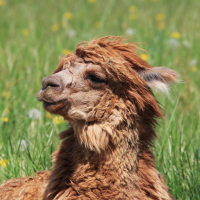big problem with damage
 lynnma
Registered Users, Retired Mod Posts: 5,208 Major grins
lynnma
Registered Users, Retired Mod Posts: 5,208 Major grins
Hello dears, long time no see 
Major problem, I do some volunteer work fixing damaged images.. I may have bitten off more than I can chew this time. I've cut a piece of the image out to protect the innocent and would love it if any of you gurus can come up with a workflow on how to fix the color damage. If it was going to black and white I have no problem.. choose the blue channel where the damage hardly shows create an alpha channel and work from there.. but in color??? I'm having a real hard time. I could just go ahead and clone away for days on end and probably will in the end but there has to be a way... right? I even got a pretty nice black and white and tried to re color it, all was good until I came to the face.. just didn't look natural enough to me.. anyone have any ideas??? it's a challenge, I'm throwing down the gauntlet!
and would love it if any of you gurus can come up with a workflow on how to fix the color damage. If it was going to black and white I have no problem.. choose the blue channel where the damage hardly shows create an alpha channel and work from there.. but in color??? I'm having a real hard time. I could just go ahead and clone away for days on end and probably will in the end but there has to be a way... right? I even got a pretty nice black and white and tried to re color it, all was good until I came to the face.. just didn't look natural enough to me.. anyone have any ideas??? it's a challenge, I'm throwing down the gauntlet!

Major problem, I do some volunteer work fixing damaged images.. I may have bitten off more than I can chew this time. I've cut a piece of the image out to protect the innocent

0
Comments
In Photoshop, copy the blue channel data and paste it in as a new layer. Change the layer to luminosity blend mode. This may change some colours, so perhaps layer mask out where it does not help (or only where it does help). You can also do a copy merged and paste as a new layer, then run large surface blur, median filters to "blend" the colour artifacts - then set the layer to colour blend mode. This colour component averaging will tend to mute/desaturate colours, however it is simple case to boost the colour saturation at the end or to use layer masks to confine the colour filtering to only the damaged areas. Even after the large blurs in colour blend mode, one may still have to use the clone tool in the colour blend layer to fix the remaining colour issues without damaging the detail.
Using colour and luminosity blend modes in RGB mode, one can "separate" the image edits in a similar way that Lab mode separates colour and tone.
I have attached a quick sample that probably took around 30 seconds. This should give you a much better start before using the healing tools, clone tools etc.
P.S. You may wish to apply a "smart noise" layer over the final retouched image, in order to unify the grain/noise of the retouched and non-retouched areas:
http://members.ozemail.com.au/~binaryfx/howto_smartnoise.html
Regards,
Stephen Marsh
http://members.ozemail.com.au/~binaryfx/
http://prepression.blogspot.com/
This will give me a wonderful start. Thanks again.
Lynn
I have CS5 by the way. Sorry to be so dense. ( I think I'm getting it, slowly, using masks.. forgot that part
Lynn
Sure I can go into more detail on the colour component cleanup... The idea is to blur a copy of the colour image, just enough to reduce or remove the colour artifacts.
Do a copy merged, or just a copy of the original layer so that all R, G, B channel data is copied. Paste that above the luminosity layer for now (target the appropriate layer when you copy).
Now it is time to average/blend out the colour component issues. Don't worry about any detail loss, that is easily fixed. Run a surface blur, smart blur, median and or gaussian blur to blend the colour artifacts together. I prefer to use large values in surface blur, smart blur or median and small values in gaussian blur (as gaussian blur spreads too much, both a blessing and a curse). Once you are done, set the layer to color blend mode (the opposite of luminosity blend).
While you are in this color blend layer, you may need to do some clone work, cloning good colour areas over bad. One can also just use a brush to paint in colour where needed, however I like to clone as the data is variable and the result is often more natural.
http://members.ozemail.com.au/~binaryfx/howto_colourblur.html
Please let me know if you still need more info.
Regards,
Stephen Marsh
http://members.ozemail.com.au/~binaryfx/
http://prepression.blogspot.com/
Thank you again.. I got a much better result.. still not so good (for me
Thanks again... It's sunk in.. I finally got a good result, doesn't do anything for the damage, but the color damage is much easier to get rid of.
Glad to help Lynn. Yes, the colour component damage is easy enough to fix with colour blend blurs and colour blend clone tool work. Again, yes, the luminosity damage can be helped a bit with a blend from the blue channel in luminosity mode - however you will still need to use the healing tools and or clone stamp or other methods. The point is that with these separate colour component and luminosity component edits, you should hopefully have faster and better results than just working with the original image in regular normal blend mode.
Stephen Marsh
http://members.ozemail.com.au/~binaryfx/
http://prepression.blogspot.com/